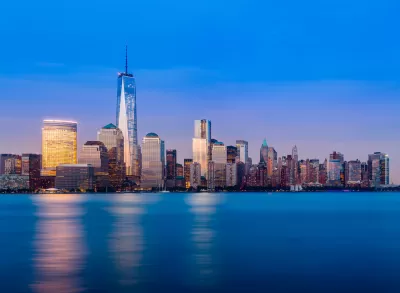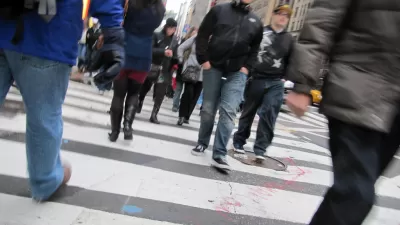In the period since 9/11, Lower Manhattan has undergone a residential boom. With daytime professionals and tourists also in the mix, the strain is showing.

New York City, Manhattan is particular, is growing rapidly. Winnie Hu writes, "By 2000, the city’s population had passed eight million for the first time. Today, it is 8.5 million and counting. By 2040, it is expected to hit nine million, according to city projections."
Despite the damage of September 11, Lower Manhattan has shared in those riches, growing into a residential hub as well as a commercial one. But there is a downside: overcrowding. Said one resident: "We always wished for more restaurants and bars, but what's come with that is trash, noise and congestion. It's one of those double-edged swords."
Part of the story is the disruption that ongoing development causes. "Construction is booming, with 2,465 permits issued for new building projects in 2015, up from 1,517 in 2010, rebounding from an earlier dip during the recession. [...] A labyrinth of imposing metal scaffolding hems in available walkways and forces pedestrians closer together, or into the street."
Trash collection is another problem, as are overcrowded sidewalks. One resident, Hu writes, "used to ride [bikeshare] from her apartment in TriBeCa to her office on Maiden Lane in the financial district nearly every day. But as more pedestrians and cyclists filled the streets, she had to concentrate to avoid running into anyone or being run into."
The area's street layout doesn't help. Lower Manhattan's "residential skyscrapers sit on a colonial-era maze of narrow streets that was not designed for the masses. The city's rectilinear grid above Houston Street allows for better mobility."
FULL STORY: Downside of Lower Manhattan’s Boom: It’s Just Too Crowded

Planetizen Federal Action Tracker
A weekly monitor of how Trump’s orders and actions are impacting planners and planning in America.

Maui's Vacation Rental Debate Turns Ugly
Verbal attacks, misinformation campaigns and fistfights plague a high-stakes debate to convert thousands of vacation rentals into long-term housing.

Cuomo Is the Candidate of Both NIMBYs and Developers. What Gives?
In the New York City mayoral race, odd bedfellows align to preserve the housing status quo.

Amtrak Rolls Out New Orleans to Alabama “Mardi Gras” Train
The new service will operate morning and evening departures between Mobile and New Orleans.

The Subversive Car-Free Guide to Trump's Great American Road Trip
Car-free ways to access Chicagoland’s best tourist attractions.

San Antonio and Austin are Fusing Into one Massive Megaregion
The region spanning the two central Texas cities is growing fast, posing challenges for local infrastructure and water supplies.
Urban Design for Planners 1: Software Tools
This six-course series explores essential urban design concepts using open source software and equips planners with the tools they need to participate fully in the urban design process.
Planning for Universal Design
Learn the tools for implementing Universal Design in planning regulations.
Heyer Gruel & Associates PA
JM Goldson LLC
Custer County Colorado
City of Camden Redevelopment Agency
City of Astoria
Transportation Research & Education Center (TREC) at Portland State University
Jefferson Parish Government
Camden Redevelopment Agency
City of Claremont





























